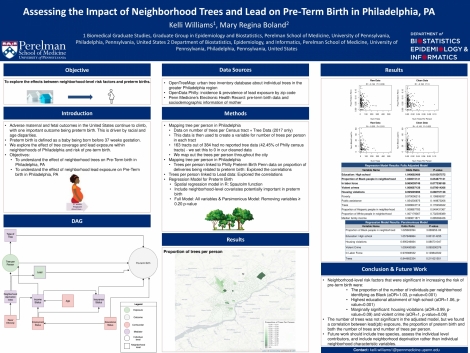Kelli Williams
Assessing the Impact of Neighborhood Trees and Pre-Term Birth in Philadelphia, PA
Abstract
Adverse maternal and fetal outcomes in the United States continue to climb, with one important outcome being preterm birth. We explore the effect of tree coverage within neighborhoods of Philadelphia and risk of pre-term birth. Preterm birth is defined as a baby being born before 37 weeks gestation. We created a Directed Acyclic Graph (DAG) for both individual and neighborhood factors important in our exposure (trees) and outcome (pre-term birth) processes. We focused on neighborhood-level analysis with data obtained from OpenTreeMap, OpenData Philly, and Penn Medicine’s Electronic Health Record. Trees were mapped per person per Census tract, which was then linked to Penn’s preterm birth data based on the proportion of preterm deliveries, and separately linked to public lead exposure data. We constructed a spatial regression model to explore the correlations using the R software language. Results showed that neighborhood-level risk factors that were significant in increasing the risk of pre-term birth were the proportion of the number of individuals per neighborhood identifying as Black (aOR=1.03, p-value<0.001), highest educational attainment of high school (aOR=1.06, p-value=0.001) and marginally significant were housing violations (aOR=0.99, p-value=0.09), and violent crime (aOR=1, p-value=0.09). While the number of trees was not significant in the adjusted model, we did find a correlation between lead(pb) exposure, the proportion of preterm birth and both the number of trees and number of trees per person. Future work should include tree species, assess the individual level contributors, and include neighborhood deprivation rather than individual neighborhood characteristic variables.
Keywords
maternal outcomes, fetal outcomes, preterm birth, trees, leadAbout Us
To understand health and disease today, we need new thinking and novel science —the kind we create when multiple disciplines work together from the ground up. That is why this department has put forward a bold vision in population-health science: a single academic home for biostatistics, epidemiology and informatics.
© 2023 Trustees of the University of Pennsylvania. All rights reserved.. | Disclaimer




Comments